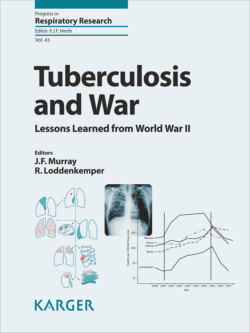Читать книгу Tuberculosis and War - Группа авторов - Страница 61
На сайте Литреса книга снята с продажи.
Post-War TB Control
ОглавлениеAfter the war, an almost catastrophic TB situation was present in many countries. The TB control programs were often almost completely disrupted, in particular in the most affected countries. Thus, it was necessary to restore or restructure the TB services.
In 1943, the United Nations Relief and Rehabilitation Administration (UNRRA) was founded, which became part of the United Nations in 1945. Its purpose was to “plan, co-ordinate, administer or arrange for the administration of measures for the relief of victims of war in any area under the control of any of the United Nations through the provision of food, fuel, clothing, shelter and other basic necessities, medical and other essential services.” UNRRA cooperated closely with dozens of volunteer charitable organizations, today called non-governmental organizations (NGOs). In Germany and Austria, these tasks were mainly organized by the military governments of the Allies.
One of the main and most urgent problems was the shortage of food. If possible, food supplements were provided to TB patients. The number of hospital and sanatorium beds for TB patients had to be substantially increased, and technical equipment for diagnostic and therapeutic purposes had to be supplied as radiographs, fluoroscopes, microscopes, pneumothorax apparatus, thoracoscopes, and other surgical instruments; doctors and nurses had to be trained, and case finding and case supervision by the local public health organizations had to be intensified to get reliable epidemiological statistics. Repeat mass radiography screening and tuberculin testing were introduced in some countries to find infected and diseased TB cases as was – for prevention – a BCG vaccination program (in some European countries with the help of Danish and Swedish Red Cross); the housing accommodation had to be improved; the pasteurization of milk and the culling of infected cattle was started or enhanced.
The International Union against Tuberculosis (IUAT) resumed its activities in 1946 [45], and became – after the founding of the WHO in 1946 – the first NGO to be officially recognised by WHO. National TB organizations and societies enhanced their activities, too, and improved international co-operation. Research in TB diagnostics, therapy, and prevention was essentially stimulated by the discovery of anti-tuberculosis agents. Almost simultaneously at the end of 1944 – only 3 weeks apart – the first para-aminosalicyclic acid was used successfully in Sweden and thereafter streptomycin in the USA for the treatment of active TB in each one patient [46]. Other cases with successful treatment soon followed, which started a new era in the fight against TB and contributed substantially to the further success of TB control after WWII. But, as is well known, the hope expressed by Daniels in 1949 that TB “should be almost eradicated before this century is out” has not been fulfilled [4].
